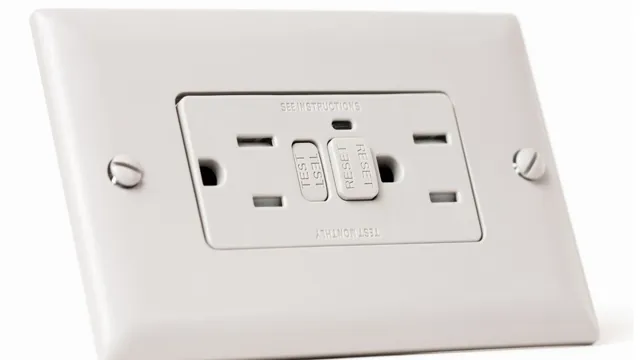Have you ever experienced your GFCI tripping even when nothing was plugged in? It can be frustrating and concerning at the same time. However, it’s not uncommon for GFCIs to trip for various reasons, whether there’s something plugged in or not. Ground Fault Circuit Interrupters (GFCIs) are electrical safety devices designed to protect you from electrical shock.
They work by monitoring the electrical current flowing through an electrical circuit and shutting it off if there’s an imbalance in the current. This imbalance, also known as a ground fault, can occur when electricity flows through an unintended pathway, such as water or a person’s body, instead of the intended path. Many factors can cause GFCIs to trip, including faulty wiring, damaged appliances, and an overload of the electrical circuit.
Delayed trips can also be caused by factors such as moisture or humidity. GFCIs can also be sensitive to electrical surges, causing them to trip intermittently. To solve the issue of a GFCI tripping with nothing plugged in, try unplugging all electrical equipment connected to the same circuit, then resetting the GFCI.
If the GFCI still trips, it may be an indication of damaged wiring, defective GFCI or a more complex electrical problem that requires the attention of a trained electrician. In conclusion, GFCI tripping without anything plugged in is not an uncommon occurrence, and it can be caused by several factors. However, proper troubleshooting can help you identify the root cause of the issue and avoid any electrical hazards.
Understanding GFCI
What causes a GFCI to trip with nothing plugged in? This is a common question asked by homeowners who have experienced this issue. One possible reason why a GFCI may trip with nothing plugged in is due to moisture or grounding issues. If a GFCI outlet is located in a damp area, such as a bathroom or kitchen, it may trip due to the presence of moisture.
On the other hand, if the wiring in the outlet is not properly grounded, the GFCI may detect a fault and trip, even if nothing is plugged in. Additionally, a faulty GFCI may also cause it to trip with no apparent cause. If you are experiencing this issue, it is best to consult with a licensed electrician to diagnose and fix the problem.
Remember, GFCI outlets are designed to protect you and your family from electrical shocks, so it’s essential not to ignore the issue.
Definition of GFCI
GFCI, ground fault circuit interrupter A GFCI, also known as a ground fault circuit interrupter, is a device designed to prevent electrical shocks. It works by constantly monitoring the flow of electricity through a circuit, detecting any imbalances or disruptions. When it detects an abnormal flow of electricity, it automatically shuts off the power to that circuit, preventing the possibility of electrocution.
GFCIs can be installed in various electrical outlets throughout a building, including bathrooms, kitchens, and outdoor areas. They are especially important in areas where water is present, as water can increase the risk of electrical shock. GFCIs are a crucial safety feature in modern electrical systems, and their widespread use has helped to prevent countless accidents and injuries.

How GFCI works
GFCI GFCI, or Ground Fault Circuit Interrupter, is an electrical safety device that is designed to protect people against electrical shock. It does this by monitoring the electrical current flowing through a circuit. If there is a discrepancy in the amount of current flowing into and out of the circuit (as little as 4-5 milliamps), the GFCI will quickly shut off the power to the circuit.
This prevents the electricity from going through a person’s body and causing harm. Think of it as a safety guard on a pool. Just like how a lifeguard monitors swimmers for any signs of distress, the GFCI monitors the electric current for any irregularities.
The moment something suspicious is detected, it filters out the electricity to ensure that no one gets hurt. A GFCI is usually found in areas where there is a high risk of electrical shock, such as bathrooms and kitchens. But it’s important to note that GFCIs are not foolproof and should not be used as a substitute for safe electrical practices.
Always be mindful and cautious when handling electrical appliances, and never stick your fingers or any metal objects into electrical outlets. With the proper precautions, a GFCI can be an effective way to ensure your safety from electrical shocks.
Reasons for Tripping
If you’re experiencing a situation where your GFCI outlet keeps tripping with nothing plugged in, you might be wondering what could be the cause. There are a few potential reasons for this, including a faulty outlet, moisture in the air, or a wiring issue. It could also be due to an overload on the circuit, as GFCI outlets are designed to trip when there is an excessive amount of current flowing through them.
If you’ve ruled out all of these potential causes and your outlet still keeps tripping, it might be time to call in an electrician to inspect the wiring and ensure that everything is functioning properly. In the meantime, be patient and try to avoid overloading the circuit by only plugging in necessary appliances and devices. It’s always better to be safe than sorry when dealing with electrical issues.
Ground Faults
Ground Faults Ground faults occur when there is an unintentional electrical connection between an electrical circuit and the ground. This can happen when a wire is damaged or comes into contact with a conductive material. Ground faults are dangerous because they can cause electric shock, electrocution, and even fire.
The primary reason why ground faults tripping is to prevent damage to appliances, electrical systems, and most importantly, to protect humans from electrocution. If the ground fault circuit interrupter (GFCI) detects a ground fault, it will immediately cut off the power source to the affected circuit. There are several reasons why ground faults trip, including water getting into electrical outlets or appliances, faulty wiring, overloaded circuits, and damaged appliances.
In some cases, the GFCI may trip even when there is no visible fault. In such cases, the GFCI could be malfunctioning and should be inspected by a professional. In general, it’s essential to take ground faults seriously and ensure that all electrical systems and appliances are installed correctly, regularly maintained, and any faults are addressed promptly.
Overloading
Overloading electrical circuits can lead to tripping, which is a safety feature designed to prevent electrical fires or electrocution. There are several reasons why overloading can occur. One common cause is using too many appliances at once, especially those with high wattage.
For example, plugging in a space heater and a hair dryer, while also using the microwave or toaster, can easily overwhelm a circuit. Another reason for overloading is the age of the wiring or circuit breaker itself, which can deteriorate over time and become less efficient at handling electrical loads. In some cases, an overloading circuit can also be indicative of a more serious electrical problem, such as a short circuit or a ground fault.
That’s why it’s important to pay attention to the warning signs of overloading, such as flickering lights, buzzing sounds, or hot outlets. By being proactive and taking steps to reduce your energy usage or upgrade your electrical system, you can avoid overloading and prevent potential hazards in your home or workplace.
Short Circuit
Short Circuit A short circuit in your house can be a real pain, leading to the tripping of circuit breakers and causing damage to your electrical equipment. A short circuit occurs when a low-resistance pathway is created across electrical conductors that are supposed to be supplying power to your devices, leading to an excessive flow of current. The sudden surge in electricity causes the circuit breaker to trip, cutting off the power supply and preventing further damage.
The most common causes of short circuits are faulty wiring, damaged cords, and damaged electrical appliances. It’s important to address short circuits immediately to prevent fires and other safety hazards. Ensure that cords and appliances are in good condition and have them checked by a professional electrician regularly.
Taking proactive steps to prevent short circuits will keep you and your household safe.
Other Factors that can Cause Tripping
If your GFCI outlet is tripping frequently, and there is nothing plugged into it, several other factors can be responsible for this problem. One possible cause may be a faulty GFCI outlet itself, which means you may need to replace it. Another reason could be the wiring in your home’s electrical system, or a damaged appliance that you haven’t discovered yet.
Ground-faults, also known as “faulty insulation,” can also cause GFCI outlets to trip for no apparent reason. A ground-fault occurs when an electrical current flows through your home’s electrical system’s ground wire instead of its intended pathway. Even a small amount of voltage to the ground wire can cause your GFCI outlet to trip.
Furthermore, changes in temperature, humidity, or even your home’s wiring structure can result in GFCI outlet tripping. Finally, it’s worth noting that resetting your GFCI outlet shouldn’t be considered a long-term solution, as it can mask any underlying electrical issues in your home. If the problem persists, it’s best to call an electrician to diagnose and repair your electrical system.
Moisture and Humidity
Moisture and humidity can be huge factors in electrical tripping, especially in areas like bathrooms and kitchens. High humidity levels can cause moisture to accumulate around electrical outlets and appliances, leading to short circuits and ground faults. It’s important to keep these areas well-ventilated and dry to avoid these dangerous situations.
Additionally, moisture in the air can cause electrical insulation to break down, which can lead to tripping as well. This is particularly common in humid environments or when using electrical equipment in wet conditions. Be aware of these factors when using any electrical devices, and always ensure they are kept dry and well-maintained.
By taking these precautions, you can prevent tripping and other electrical hazards in your home or workplace.
Wiring Faults
Wiring Faults While wiring faults are one of the most common culprits of tripping breakers, there are other factors that can cause this annoying issue. One major factor is overloading your electrical circuit. When too many appliances or devices are connected to one circuit, it can exceed the circuit’s capacity and cause a circuit overload, leading to tripping.
Another factor is a short circuit, which occurs when a hot wire comes in contact with a neutral wire. This creates a low-resistance path for current, causing a surge and ultimately tripping the circuit breaker. Lastly, a ground fault can cause a breaker to trip.
A ground fault occurs when an electrical current strays from its intended path and travels through a person’s body to the ground. If a fault occurs in your home, it’s important to determine the cause and fix it immediately to avoid any further issues.
Troubleshooting Tips
If you have found yourself in a situation where your GFCI is tripping with nothing plugged in, it can be frustrating and confusing. However, there are a few common causes that could be triggering it. One reason could be that there is moisture or water present near the receptacle, causing an imbalance in current flow.
Another culprit could be a ground fault in the wiring, which can occur when the hot and neutral wires come in contact. Additionally, a faulty GFCI itself can also be the reason behind the tripping. It’s important to test your GFCI periodically and replace it if it’s malfunctioning.
If you’re unsure about how to diagnose the problem, it’s always best to consult a professional electrician. Ultimately, it’s important to address GFCI issues sooner rather than later to ensure the safety of yourself and your home.
Resetting the GFCI
When a GFCI outlet stops working, it can be frustrating to figure out what’s wrong. But before you panic and call an electrician, try resetting the GFCI. GFCI outlets are designed to trip when they detect a ground fault, which could be caused by a faulty appliance or device plugged into the outlet.
To reset the GFCI, start by unplugging everything from the affected outlet. Look for the “TEST” button on the outlet and press it firmly. If the outlet is working properly, you should hear a click.
Finally, press the “RESET” button, which should be right next to the “TEST” button. If the reset button clicks, it means power has been restored to the outlet. If the GFCI keeps tripping, however, it may be a sign of a more serious electrical issue, and you should consult a licensed electrician to examine the problem.
Remember, safety first! When dealing with electricity, always exercise caution and prioritize your well-being.
Testing the Circuit
When testing a circuit and hoping to troubleshoot any potential issues, there are a few things to keep in mind. First and foremost, it’s important to double-check that all connections are secure and in the proper place. Loose wires or components that aren’t fully connected can cause significant issues, so it’s worth taking a few extra minutes to ensure everything is in place.
Additionally, it’s never a bad idea to check for any potential shorts or other problems that could be preventing the circuit from working as intended. This can typically be done using a multimeter or other testing tools. Finally, don’t be afraid to reach out for help if you’re not sure what’s going on.
Sometimes, an outside perspective or additional expertise can be invaluable in troubleshooting a circuit. By keeping these tips in mind and staying persistent, you can ensure that your circuit functions properly and remains safe to use.
Conclusion
It’s a classic case of technological prudishness. Your GFCI, like a modern-day monk, is just overly cautious and sensitive when it comes to electricity. Even the slightest hint of an electrical imbalance or disturbance can send it into a tizzy, triggering a trip and shutting down the party before it’s even started.
So, next time you’re scratching your head over your GFCI’s mysterious behavior, just remember: it’s simply doing its duty to protect you and your home from any potential electrical mishaps. Sort of like a chaperone at a high school dance – not the most fun, but definitely necessary!”
FAQs
What is a GFCI?
A GFCI (ground fault circuit interrupter) is an electrical safety device that is designed to trip a circuit when it detects a ground fault.
Can a GFCI trip with nothing plugged in?
Yes, a GFCI can trip even if nothing is plugged in because it detects ground faults, which can occur even without a load connected to the circuit.
Why would a GFCI trip for no apparent reason?
There are several reasons why a GFCI may trip for no apparent reason, including moisture or water damage, faulty wiring, or a malfunctioning GFCI device.
How do you troubleshoot a GFCI that keeps tripping with nothing plugged in?
Troubleshooting a GFCI that keeps tripping with nothing plugged in involves checking for moisture or water damage, resetting the GFCI device, checking the wiring, and replacing the GFCI if necessary.
Is it safe to use a GFCI that keeps tripping?
No, it is not safe to use a GFCI that keeps tripping as it may indicate an underlying electrical issue that could pose a serious safety hazard.
How often should a GFCI be replaced?
It is recommended to replace GFCI devices every 5-10 years, depending on usage and wear and tear.
Can a GFCI be tripped by a power surge?
It is possible for a power surge to trip a GFCI device, but it is not a common occurrence as GFCIs are designed to detect ground faults, not power surges.






